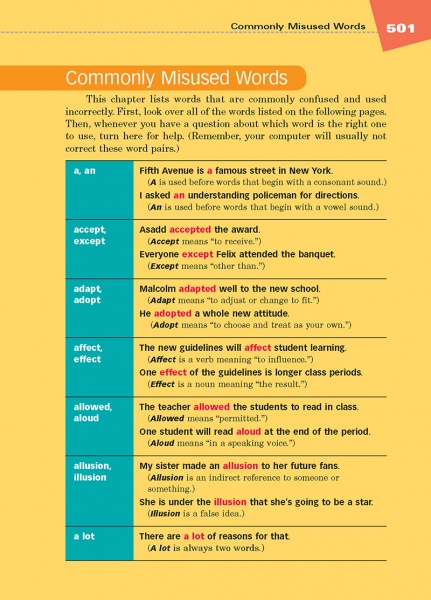Page 501 from

Start-Up Activity
Show your students a picture of the Olsen Twins. Challenge them to identify which one is Mary-Kate and which one is Ashley. It's tough because they look so similar.
Play a recording of Frank Sinatra and Harry Connick, Jr. Challenge students to identify which is which. They sound very similar, but they are two different singers.
Then tell students that the Engelbert Humperdinck who wrote the opera Hansel and Gretel is completely different from the Engelbert Humperdinck who recorded "Strangers in the Night"
When two different things look the same or sound the same or have the same name, confusion is inevitable. This section helps students sort out commonly misused words, choosing the best ones throughout.
Often, students can create mnemonic devices (memory aids) to help them remember differences. For example, students can remember that accept looks like access (allowing in), while except looks like exit (sending out). Challenge your students to come up with their own mnemonics on this page and those that follow.
Think About It
“Words are how people think. When you misuse words, you diminish your ability to think clearly and truthfully.”
—Margaret Heffernan

Start-Up Activity
Show your students a picture of the Olsen Twins. Challenge them to identify which one is Mary-Kate and which one is Ashley. It's tough because they look so similar.
Play a recording of Frank Sinatra and Harry Connick, Jr. Challenge students to identify which is which. They sound very similar, but they are two different singers.
Then tell students that the Engelbert Humperdinck who wrote the opera Hansel and Gretel is completely different from the Engelbert Humperdinck who recorded "Strangers in the Night"
When two different things look the same or sound the same or have the same name, confusion is inevitable. This section helps students sort out commonly misused words, choosing the best ones throughout.
Often, students can create mnemonic devices (memory aids) to help them remember differences. For example, students can remember that accept looks like access (allowing in), while except looks like exit (sending out). Challenge your students to come up with their own mnemonics on this page and those that follow.
Think About It
“Words are how people think. When you misuse words, you diminish your ability to think clearly and truthfully.”
—Margaret Heffernan
